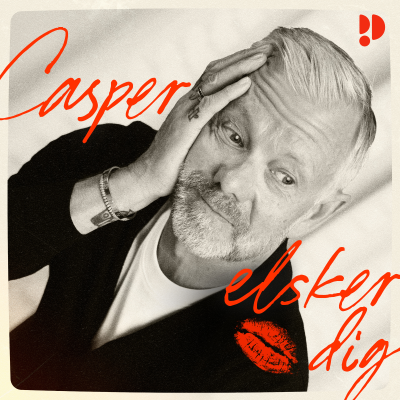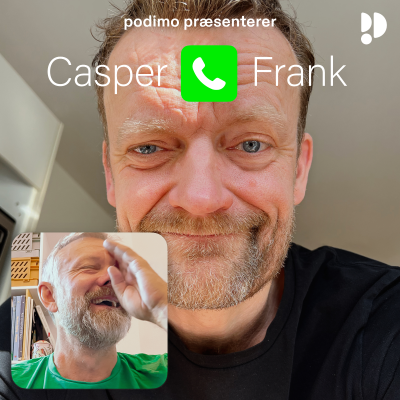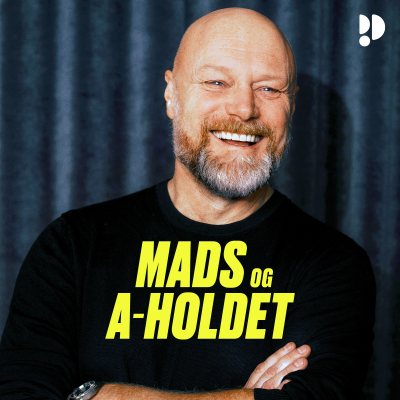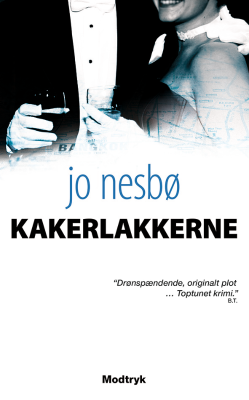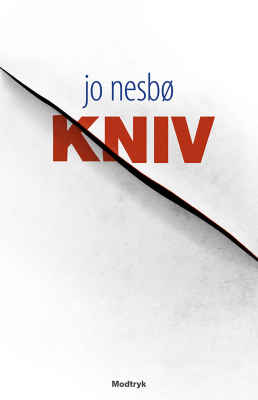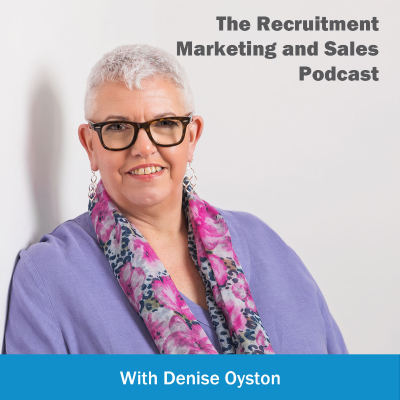
Podcast Archives - Superfast Recruitment
Podcast af Denise Oyston
Begrænset tilbud
2 måneder kun 19 kr.
Derefter 99 kr. / månedIngen binding.
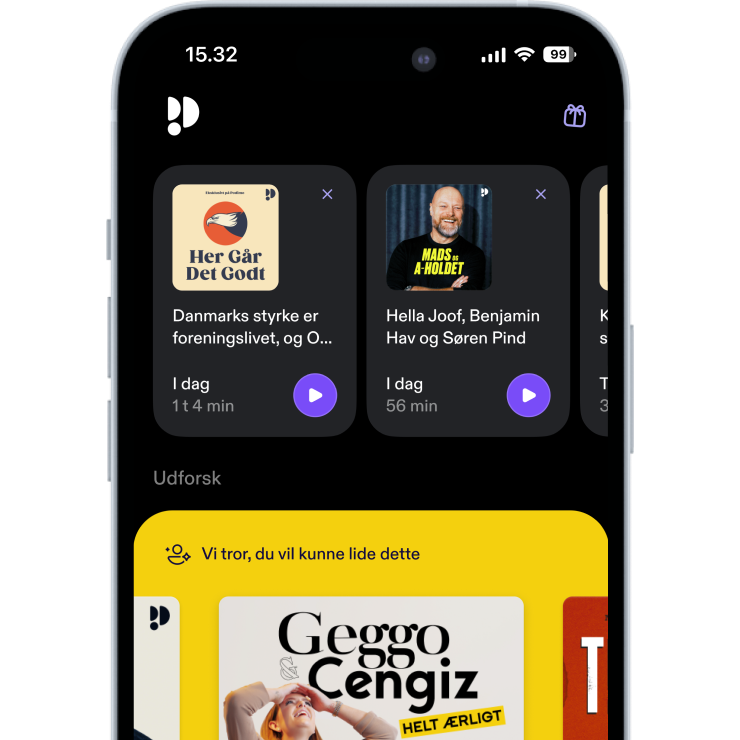
Mere end 1 million lyttere
Du vil elske Podimo, og du er ikke alene
Rated 4.7 in the App Store
Læs mere Podcast Archives - Superfast Recruitment
Specialist Recruitment Marketing
Alle episoder
330 episoderHi everyone, this is Denise, and welcome back to the Recruitment Marketing Sales Podcast. Today, we’re talking about something that’s probably causing many of you stress – the complete chaos that may pass for marketing processes in your recruitment business. I suspect if you’re reading this, you’re juggling LinkedIn outreach, content creation, candidate nurturing, client relationships, and about 15 other marketing tasks. Then there’s managing your team and growth on top of that. Here’s what I know about the majority of recruitment business owners – you’re incredible at finding talent and closing deals. Still, when it comes to systematising your marketing processes, you’re winging it. In the UK, we have this saying about “flying by the seat of your pants” or making it up as you go along. This approach is costing you time, money, and probably your sanity. In today’s environment, there’s always another piece of software you could use or another AI tool you absolutely must try. It’s easy to get overwhelmed thinking you’re losing out if you don’t buy 30 different domain names or use every new platform. That’s not the case. What you need is to focus on the basics and have systems and processes around them. You build from there. That’s what we’re talking about today – standard operating procedures, a paint-by-numbers system that literally anyone can follow and implement. WHAT IS A STANDARD OPERATING PROCEDURE? Standard operating procedures have been around for years. The earliest documented SOPs were from the British Royal Navy, which needed consistency and reliability in its operations. They needed tasks completed within a specific timeframe with documented processes for onboarding tasks. SOPs became widespread during the Industrial Revolution, and the military adopted the formalisation of these procedures. As small business owners, we use them now for workflow and getting things done in a timely manner without losing our minds. An SOP is fundamentally the basics – it stands for standard operating procedure. It’s simply a step-by-step guide that documents how to complete a specific task or process in your business. Think about it logically – it’s like a recipe. But instead of making a cake or apple crumble, you’re creating a repeatable system for onboarding a new client or creating LinkedIn content. Over the years, SOPs have grown in their use, particularly with remote work. For marketing SOPs, there’s another element you can add – creating a video of the process. This is quite nuanced for marketing because you can record yourself doing something, and that video becomes a training resource. Here’s where most business owners get it wrong – SOPs don’t need to be fancy. They don’t need lots of workflows and fancy formatting. The best SOPs are simple, clear bullet points: Step one, Step two, Step three, Step four. They work well when you have a video to watch simultaneously. Simple Word document processes work particularly well for slightly more technical processes. Something I do is screen grabs using the snipping tool. You can paste these into your recipe if that works for you. WHY RECRUITMENT BUSINESSES NEED MARKETING SOPS As a recruitment business, SOPs are particularly crucial because your marketing activities are relationship-based and require consistency. When you’re building relationships with candidates and clients, you can’t afford to be inconsistent in your approach. If you stop posting or a random post goes out that doesn’t follow your format, such as the wrong colour or imagery, it can impact your brand. Let me give you examples of marketing SOPs that every recruitment business should consider: Content creation SOPs could include how to research and write LinkedIn posts that generate leads, how to create video content for candidates, how to create video content for clients, and how to repurpose one piece of content across multiple platforms. Lead generation SOPs might cover how to identify and research potential clients, how to implement a LinkedIn outreach campaign, and how to follow up with prospects. Imagine having all of these that your team could follow, so you know things are getting done right. Using and implementing these systems is important with your team because you want to support them. SOPs do that and minimise the number of questions you get. I often say to team members, “Have you watched the SOP video and followed the SOP? Go back and look at them.” They’ll come back saying they worked it out because they’d missed step five or six. People often think they remember things, but even I use SOPs. For our email marketing, I know how to do everything, but I haven’t done it for a few weeks because a different team member has been handling it. So, I go back to the SOP to remind myself which button to click. They’re helpful as memory joggers for people implementing the process. THE SARAH SUCCESS STORY: FROM CHAOS TO CONSISTENCY Let me share about Sarah, who runs a recruitment company. Every week, she posted on LinkedIn ten times at completely random times whenever she got a spare minute. Sometimes she posted about industry trends, sometimes personal branding posts, testimonials, or just something interesting she found. Her engagement was inconsistent. She wasn’t getting many views and wasn’t sure what was working. I had a conversation with Sarah about creating an SOP for LinkedIn content creation. She now has a system: Monday is industry insights, Wednesday is success stories, Thursday is a poll, Friday is career advice. She has templates for each type of post. Once she started doing this, her engagement shot through the roof because she was doing something consistently. We’ve all experienced looking for something on a particular day. Most people listening to this podcast know that every Friday, you get a short email from us saying, “Here’s our latest podcast, you might find it useful.” It’s consistency. By knowing what to do when, people start looking for things. We’ve all watched soaps on TV and know they’re on at certain times. The BBC has news at 6:00 and 10:00 every night. I’m wired to look because I usually work till 6:00 in the evening and time it to one minute to six. That’s how people are wired – they’re looking for things from you. Having that SOP makes a huge difference. THE HIDDEN BENEFITS OF MARKETING SOPS Let me share more benefits of creating SOPs that might convince you further. Consistency builds trust. In recruitment, consistency is everything. Your clients need to know they can rely on you. Your candidates need to feel confident in the process. When you have SOPs for marketing activities, you ensure every touchpoint with your audience reflects your brand, values, and standards while getting people excited about working with you. SOPs save you time. Have you ever thought, “Do I need to do this first, or that first?” only to spend time looking for passwords? You can waste hours each week on this. With your SOP, you may have saved it on your system with a search string to find it in Dropbox. That saves hours. Scalability without chaos. This is huge. Right now, for many of you, the business revolves around you, particularly if you’re new to creating content. What happens when you want to grow, hire team members, or take a holiday? SOPs help because people just need to follow them. If you’re working with a virtual assistant in the Philippines, South Africa, or anywhere remote, they can get consistent results. You become less of a bottleneck and more of the strategic leader you’ve always wanted to be. Increased quality and reduced errors. When you’re rushing through marketing tasks without a systematic approach, mistakes happen. You forget to follow up with leads, miss essential details in client communications, or publish content with errors. Having an SOP reduces these errors. One benefit I mentioned with Logan, one of our team members, is better training and onboarding. People feel included in the process. You can’t just hand someone something and say, “follow that step by step,” but having that SOP means you can go through training quickly and support your people. Documented systems mean improvement opportunities. Having a documented system means you can identify and implement improvements. If you see something that could be done more efficiently, having an SOP gives you something to examine and modify. There’s something valuable about peace of mind that’s hard to quantify. When you’ve got systems in place, you can take time off without worrying that your marketing is falling apart. You can focus on strategy rather than constantly putting out fires. HOW TO CREATE YOUR FIRST MARKETING SOP I’m going to share the simple process for creating a marketing SOP. Here’s something that’s not popular but necessary – you need to do it, not somebody else. You want the business done your way. Our team members have training videos and resources. I’m talking to people creating SOPs themselves. The important thing is you know what you want and how you want it delivered. When we had our bigger marketing agency writing content, I used to drive people mad because I wanted things delivered in a certain way. I wanted our clients to get a great experience, and I wanted the documents they received formatted the same way – same font, same point size. We used Calibri 11 point with subheadings at 16 points. I wanted consistency. I didn’t want it looking like what we call in the UK “a dog’s breakfast.” Creating that SOP fell to me. Yes, it’s time-consuming, but things get done your way. You can ask for feedback and adapt things – people might add something to the conversation. However, doing the SOP yourself works well. Here’s how I create an SOP using a simple three-step process: First, record yourself doing the task. A great way to do this is using Zoom. In Zoom, there’s a button you can click that will transcribe your audio from the video, which is brilliant. When you record doing the task, and this has to be said, don’t mumble, don’t speak fast, don’t be clicking rapidly. Someone doing this process may not have done it before. Go through the task painfully slowly so they understand every part of the process. Second, get the video transcribed. If you’re using something other than Zoom as a video recorder, you need to get a transcription. This is where it becomes amazing because AI is so helpful. Third, use AI to create your SOP. If you have the transcription from your video recording, you can use your favourite AI tool – there are multiple ones out there. The paid ones are always better, whether it’s ChatGPT or Claude (one of my favourites). You get your transcription and put a prompt into your AI tool. Give a detailed prompt like: “I have a transcription of myself performing writing a personal branding post. Please create a comprehensive standard operating procedure based on this transcription. Please number it from one to the final number. Leave spacing. Start with a capital letter. Please make it practical and easy to follow for someone who hasn’t done this task before. Here’s the transcription.” AI will work its magic and usually come up with something more than usable. You must read through it all and check the nuances because sometimes AI tools can produce ridiculous things. Make sure you go through and tweak anything needed. Then I test it by following it to the letter myself to see how it works. I can tweak it if I’ve missed something during the recording. Remember, AI can only work with what you give it. If you forgot to mention clicking somewhere or saving something, AI won’t pick that up because you missed it in the video. That’s something anyone can do when creating an SOP. Record yourself doing the process. Use the transcription given to you or use a tool to transcribe it (there are Otter, Sonix, Descript, and multiple AI transcribing tools that do it almost instantly). Then, you’ve got your SOP. We have a folder with different people accessing it – a secure business version of Dropbox with a training folder inside. Every single process is listed out with videos recorded and SOPs from those videos. BEYOND MARKETING: WHERE ELSE SOPS WORK Imagine by the end of summer having SOPs created for key functions in your business. If you have a marketer, you could ask them to make an SOP on their process. Then, if they’re on holiday or you become busy, one of their colleagues can use the same process. SOPs aren’t just for marketing. They could be for sales too. I was brought up with sales scripts, and they’re brilliant despite what anyone tells you. They put multiple six figures into my bank account over the years. Consider the value and beauty of how you can use SOPs in other parts of your business. This is a foolproof process I’ve used that works incredibly well. Thanks Denise HOW WE CAN HELP Creating effective marketing SOPs is just one part of building a scalable recruitment business. If you’re ready to systematise your marketing processes and stop winging it with your business growth, we can help. Our programmes give you the frameworks, templates, and step-by-step guidance to create marketing systems that work for recruitment businesses. You’ll get the SOPs, the training videos, and the ongoing support to implement them properly in your business. The post Why Marketing SOPs Save Recruitment Business Sanity [https://www.superfastrecruitment.co.uk/why-marketing-sops-save-recruitment-business-sanity/] appeared first on Superfast Recruitment [https://www.superfastrecruitment.co.uk].
This week’s post and podcast is about building effective marketing systems for recruitment businesses. I’m continuing our series on systems because I believe it’s the perfect time of year to get everything in place and prepare ahead of time. Last week, I covered why systems are so important – their beauty and the key ones you need in your business. Today, I want to provide you with specific examples of setting up systems and outline some actions you can take now to get them in place. If you’re new here, welcome! It’s great to have you. If you have a recruiter friend or colleague who would appreciate listening to this podcast, please share the link with them. Please share it with them on iTunes or Spotify or give us a shoutout on LinkedIn. I appreciate it. This podcast isn’t sponsored. Nobody pays for this. We do it because we want to help people, and we’re doing what we teach others to do because it works. We’re providing value upfront. If you could give us a shout out, we would love it. Please consider giving us a review as well if you find it useful – that would be greatly appreciated. START WITH ONE SYSTEM AND BUILD MOMENTUM Here’s what I love about building marketing systems: you don’t need to do everything at once. When our clients start working with us as a Superfast Circle member, we provide them with a straightforward, step-by-step approach that outlines the initial steps they need to take. Over the years, many of you will know that we’ve been content marketers for approximately 18-19 years in the industry. We know what works and what yields the best return on investment the fastest. There’s a system around this, and that’s something I always want you to remember. When people often ask where to start, I advise them to start with one thing. It’s easy to get confused and think you’re being proactive by doing all these things. It’s much better to start with one thing – I like to call it the “pick one philosophy.” Pick one system, build it out properly, then you can move on to automation. However, I think it’s much better to get something working first. Let’s see how it performs, then we automate it. Let’s test it and work out all the glitches. Why pick just one system? Because if you don’t, you end up trying to implement everything simultaneously. This is literally where people get overwhelmed and end up implementing nothing at all. That isn’t necessary. Start with one system, build it from there, and your momentum will start to build. WHICH SYSTEM SHOULD YOU PICK FIRST Now let’s talk about which one you should pick, and I’m going to say it depends. It depends on your biggest pain point at the moment. Most of the people we work with suggest that they start with building out their client attraction system, particularly in the current market. For the majority of recruiters we work with, LinkedIn is their primary platform for finding new clients. This is where their business contacts are now. Starting with your LinkedIn content system is the fastest way to demonstrate your expertise and attract client attention. Here’s a framework for working with LinkedIn effectively. The first thing is to have different types of posts. I’m going to give a shout-out to us at Superfast Circle because we provide you with all these tools you can utilise, saving you time. However, for those of you in larger companies who wish to initiate this effort independently, here are the key considerations to keep in mind. CREATING YOUR LINKEDIN CONTENT FRAMEWORK You want market insight posts – what you’re seeing in hiring trends. You want educational posts on how to solve common hiring problems. You want social proof-style posts, such as story posts about candidate journeys, what’s happened, how you’ve helped people, different clients, and successful placements. Then there are the classic question posts – the polls people use on LinkedIn to engage with their network. You write them, you batch them, you write them in advance. Let’s say in your industry that March is a key time for people recruiting or hiring, when decisions are being made. Then you can build your content around how that might work. The next step is to create a publishing system. Many people, when they first come to us, might post once a week if we’re lucky. Unfortunately, that won’t move the needle. You need to post multiple times a week, in fact, numerous times a day. But let’s start with something easy. These aren’t just job ads you’re posting, by the way. This is content to nurture people in your market, including those you’re already connected to, as well as those you will be connected to in the future. How about posting Monday, Wednesday, and Friday? LinkedIn has a scheduling tool that’s not hard to utilise. There are several marketing automation tools you can use. Some people use Buffer. A favourite of mine recently is SmarterQueue – go and check it out. You can start posting and engaging with your client’s content. Allocate 15 minutes a day in your diary. I remember years ago – probably ten years ago, before personal branding became a thing – we suggested everyone take 15 minutes a day. I ran a webinar on it back then, and it still works. Just allocate 15 minutes. Sometimes I even set a timer. I’m on LinkedIn, interacting and engaging with people I want to engage with. Our posts are scheduled ahead of time, so they’re all ready, and I know they’ll appear. Setting up that system alone will put you ahead of so many recruiters and make a massive difference. BUILDING YOUR CONNECTION AND OUTREACH PROCESS One area where there’s often a disconnect for many recruiters is that they publish content but fail to connect it by making more connections and engaging in outreach. Everyone has a set number of LinkedIn connection requests they can send out, and this is something to do daily. It’s just like any system you create – the more you can do daily, the better it gets. One of the girls was talking about her “dailies” – she had daily tasks to complete. This isn’t necessarily around KPIs, but her dailies were what she had to do every day. When she did this, she knew it made a difference. I encourage you to create your dailies – however many connection requests you send out. Remember that momentum builds, but you must start it by being consistent. You send out a connection request. Once that person has accepted, share a piece of valuable content or an insight – no sales pitch, just value. You’re doing that with your LinkedIn connections. When it comes to what to do after that, you rinse and repeat. You continue because this is about building a process and people seeing you everywhere. I know that sometimes, if I see an ad on TV, then hear a radio ad, and then pick up a magazine, I suddenly think I should take a look at it. When I’ve seen it two or three times, there must be something about it. This is where building that system works for you. You’ve created the content, you’re now a publishing machine, and you’re connecting and doing outreach with people. The next step is to get clients on your email database or encourage them to join it. Here’s a hint: when you’re publishing things and doing connections and outreach, you can say, “I’ve got some great content and ideas for you. Would you like to join our email system?” Most people will say yes, or you send a link where they put their name and email address. You can see how all these systems build on one another. CANDIDATE ATTRACTION SYSTEMS WORK SIMILARLY If you need more candidates, it’s a similar system. Consider the content – you want to create a similar process that shares valuable content with them. When we talked about the client acquisition system, we mentioned market insights. It’s the same thing, only it comes from a candidate’s lens. We’re examining market insights because candidates are intelligent individuals. They want to know what’s going on in the market. You want to tell them about not just hiring trends, but career trends and career progression – what they need to be thinking about. You want educational posts, story posts, and those question posts. Do a survey, ask a LinkedIn poll – all these things you can use. That’s the system you set up with candidates exactly the same. You’re reaching out to candidates. You could do a certain number of LinkedIn connection requests for clients and a certain number for candidates. Add these candidates to your email system as well. Straight away, you’ve got very simple, straightforward systems that work for client attraction and candidate attraction. You take those to the next level by getting these people on the phone. You send them more messages, leave them a voice note, send them a video – all different things that make a difference. ADVANCED SYSTEMS USING LINKEDIN SALES NAVIGATOR On LinkedIn, there’s Sales Navigator – a great piece of software where you can build lists of clients and candidates. This can be a systematised process. We receive emails stating that there are X number of leads in your LinkedIn list, so you can log in because you’ve set up the criteria. You can incorporate those systems into your process. When conducting outreach within LinkedIn Sales Navigator, review all new connections and people who’ve appeared on your list that meet your criteria. Then set the process to start reaching out to them. Most problems that occur for recruiters around systems are that their systems are so sporadic. If you have a specific process that’s dialled in and you’re doing it regularly, it’s going to make a difference. We’ve all received random cold emails in our inbox that aren’t particularly relevant, and we end up blocking people. That’s where having your systems organised makes a difference. Think about your client system and your CRM. If that’s sorted by industry, sector, experience level, hiring history, or company size—whatever it is—you can compile lists of people you need to contact. Once you’ve done that, you can create that systematic approach with your touchpoints. Perhaps you could send a monthly update to them, establish an immediate follow-up system when someone joins your list, or conduct a quarterly check-in. Your business priorities will dictate this. If you do those systematic touchpoints built into a system, you have a very productive nurture campaign. Let’s say that automated nurturing you could do with candidates: you could have a new registration sequence, a post-interview follow-up sequence, a placement preparation sequence, or a post-placement sequence. All these things – if you need predictability, set up the system, and you’ll see a huge difference. Sometimes it’s painful to go into that detail. And it’s incredibly useful. I’ll cover SOPs a bit more in next week’s podcast, when I delve into that topic. We’re all about systems, and my goal is for you to review the systems you have, refine them, clean things up, and put everything in place over the summer. If you’ve kicked off some systems, then your September will be very different. The key is to start with one system, build it properly, and then expand from there. Remember, momentum builds when you’re consistent, and consistency comes from having clear, systematic processes in place. Thanks Denise HOW WE CAN HELP At Superfast Circle, we provide the complete framework and content you need to build these marketing systems effectively. Our members gain access to ready-made content templates, detailed implementation guides, and a paint-by-numbers approach that eliminates the guesswork from building your recruitment marketing systems. We’ve spent nearly two decades perfecting what works, so you don’t have to figure it out through trial and error. The post Systems-Based Recruitment: Building Your Marketing Framework [https://www.superfastrecruitment.co.uk/systems-based-recruitment-building-your-marketing-framework/] appeared first on Superfast Recruitment [https://www.superfastrecruitment.co.uk].
Hi there, everyone. This is Denise. As we move through July, it’s the perfect time for a six-month review of your recruitment business. This year has been anything but predictable, and if you’re wondering what’s happened over the past six months, you’re in the right place. The landscape has been challenging. We’ve got new governments with different approaches, tariffs in the US creating global uncertainty, and constant changes to employee and employer costs in the UK. All of this is significantly impacting recruitment. What’s been labelled a “white-collar recession” is reshaping how we source talent. Clients are demanding more for less, and it’s been a tough six months. But here’s the thing about challenges – they create opportunities too. Today, we will examine the numbers, what’s worked in sales and marketing, face some hard truths, and give you actionable ideas. THE CURRENT SALES PERFORMANCE REALITY You’re correct if you feel like it’s been tougher than usual. I recently used AI research for a client, and the global trends show the UK market is more depressed than the US market. Australia is having an unusual time, but is predicted to bounce back next year. This “white-collar recession” is a strange phenomenon in which corporate profits remain strong but hiring has dipped. However, there are several interesting contradictions. Twenty-three per cent of UK workers are planning to quit their jobs in 2025—that’s higher than the US’s 19% and Australia’s 18%. There’s movement, just not the kind we’re used to. Meanwhile, over 80% of companies report skills gaps in specific areas. Nearly nine out of ten companies are struggling to find the right talent. The need is there – it’s about how you sell your service to these companies. The professional services sector is experiencing a staggering high turnover rate. This isn’t just churn – it’s opportunity knocking loudly on your door. You’re not alone if you’ve been struggling with new client acquisition. However, if you’ve positioned yourself as a solution to skills gaps rather than just another recruitment company, you’ve likely seen some wins. Your clients aren’t looking for bodies on seats. They’re looking for predictability and recruitment partners who can anticipate their needs. Finding the right skills is five times more predictive of job performance than traditional degree-based hiring. As a recruiter, this is where you excel. MARKETING CREATES DEMAND, SALES CONVERTS IT Marketing and sales are different functions. Marketing creates demand, and sales convert that demand. Are you reaching out to a wider audience, going deeper with your current audience, or focusing on a vertical? We often realise we’re not doing as much as possible during challenging times. I spoke with a client recently who’d been following our strategies. His LinkedIn connections had grown significantly, but he went quiet when I asked about his outreach messaging. He admitted he hadn’t been reaching out like he normally would. Remember, you must convert the demand you’re creating at some point. Don’t base expectations on what happened post-pandemic. The years 2021-2023 were exceptional. As a business owner, you must consistently market more because markets change. Then you convert that demand by selling and making offers. CONTENT MARKETING: THE GAME-CHANGER FOR RECRUITMENT If you haven’t listened to my podcast about the lead generation triad, go to superfast.co.uk/LGT and watch the video. I discuss three key areas: leveraging your current database, content marketing, and cold outreach. Recruiters are doing well and utilising all these elements. Content is a huge win for recruitment business owners because it appeals to candidates and clients. It works ahead of time and continues working for you. B2B content marketing costs significantly less than traditional marketing methods and can generate up to three times the leads – check HubSpot’s research reports for verification. Very few people buy on a whim. They research, check people out, and determine if someone can help them. Content is your route to establishing this trust. The recruitment businesses that are winning are adapting, using content, understanding the market, and appreciating that hiring cycles are longer. They’re investing in educational and thought leadership content distributed through social media and email marketing. LinkedIn is a golden channel—nearly a billion people are on LinkedIn, but less than 4% post regularly. If you post twice daily on LinkedIn, you’ll stand out as someone who understands their market. You’ve likely seen increased views and interactions if you’ve been publishing thought leadership content, industry insights, and information about skills-based hiring. We run personal branding challenges with our clients, and they all report significant differences in engagement levels. You can use reports, white papers, and case studies—all of which are proving particularly impactful. People go through a buying cycle, from unaware to aware to considering to deciding. Throughout this process, they look for information and check if you’re consistently present. EMAIL MARKETING STILL DELIVERS RESULTS Email marketing remains incredibly effective. Even in the UK, you can still send cold emails. Open rates are increasing in B2B because Google and Microsoft’s cleanup campaigns have removed inactive users. Open rates between 40-50% aren’t uncommon now, compared to much lower rates 4-5 years ago. Classic data shows that for every pound spent on email marketing, you get an ROI between £30 and £40. You leave money on the table if you’re not nurturing your database with valuable content. Companies getting results now are actively implementing solutions rather than focusing on problems. They’re not sitting in pity parties complaining about the terrible market. They say, “This is what’s happening globally – what solutions can I implement?” GOING BACK TO BASICS WORKS My strong recommendation is to go back to basics during challenging times. Ask yourself: Am I doing cold outreach? Am I picking up the phone? Am I sending direct messages? Am I making more offers? Am I listening to my market? Am I adapting what I’m offering? Consistent business development (bd) is key. Those who consistently do BD are successful and continue to be successful. Regular outreach, relationship building, and promoting your services make a significant difference. The most successful businesses combine the lead generation triad – content marketing with systematic outreach processes. If you haven’t checked our YouTube channel, there’s a video recording from one of our events where Sharon goes through the six-step process. Search for “Superfast Recruitment” on YouTube. AI is incredibly useful in recruitment for administration, sorting, and sifting work. Over 30% of recruiters now use AI tools for grunt work, freeing themselves for strategic work and business development. AI helps schedule appointments and screen CVs, but remember—educational content positions you as a strategic partner. Combine marketing with business development and use AI for productivity, and you position yourself as a business worth working with. You need all these elements to work together. WHAT YOU NEED TO DO NEXT If you haven’t listened to Sharon’s belief podcast, please do. Our brains run riot with untrue thoughts, particularly in group situations with people having tough times. Our brains are wired for negativity to protect us, so remember that when planning forward. Be clear and data-driven. What were your numbers for the first half of the year? Be honest – don’t just say the market’s bad. How many outreaches have you made? No wonder you’re struggling if you’re doing the same things as 2019. Do you need to double your figures? Send more content? Set up a cold email marketing system? You’ll hear about being resilient and adaptable—these aren’t just advantages but essentials moving forward. Be resilient because there are challenging times, but also adaptable. Ask yourself: Am I open to this possibility? Could this work? It’s easy to dismiss ideas—”they won’t read that content” or “that won’t work in my sector.” Sometimes, it’s about dropping the ego and looking at what could work. A coach told me years ago to always think, “Am I open to the possibility that this might work for me?” When we started, we began with cold emailing and phone calls. I’d always worked in pharmaceuticals and had never done a cold email before. I was open to trying, and that’s how we got our first five clients. If you haven’t tried something, be open to the possibility that it might work in your sector. Marketing is about testing different things and looking at the results. There’s a saying that more millionaires are made in recessions than at any other time. Market challenges create opportunities for agile business owners. Content marketing and thought leadership help you stand out as a brand. The future belongs to recruiters who can balance AI tools and technology with human connection and understanding. I spoke with Cheryl Wang from GSR recently, and she said, “The market is changing. We need to do a bit more.” That’s exactly what’s happening. Think about what you’ll do differently. What were your main problems in the first half of the year? What are the solutions you could use moving forward? You might not like sending direct messages or setting a KPI of 20 LinkedIn invitation requests daily, but it works. It feeds your family and makes a difference as you move forward. Thanks Denise HOW WE CAN HELP If you’re ready to implement these strategies and want guidance on where to start, we can help. Our Superfast Circle program provides recruitment business owners with the content, systems, and support required to build effective lead generation strategies. We help you combine content marketing with systems that work whilst developing your brand to stand out in today’s competitive market. The post Your Mid-Year Recruitment Marketing Reality Check: What’s Working in 2025 [https://www.superfastrecruitment.co.uk/your-mid-year-recruitment-marketing-reality-check-whats-working-in-2025/] appeared first on Superfast Recruitment [https://www.superfastrecruitment.co.uk].
This week’s post and podcast discuss the most common marketing misconceptions holding recruitment businesses back. I see these myths everywhere, and they’re stopping talented recruiters from growing their companies. Let me set the record straight on what’s working in 2025. After 18 years in recruitment marketing, I’ve heard every excuse in the book. From “marketing is too expensive” to “good work speaks for itself,” these beliefs keep brilliant recruiters stuck. The truth is that the recruitment landscape has changed dramatically, and your marketing approach needs to change with it. Whether you’re a solo recruiter or running a small agency, these misconceptions could cost you clients and candidates. Let’s tackle them head-on and give you the real facts about what works in today’s market. MYTH ONE: MARKETING AND SALES ARE THE SAME THING This is probably the biggest mix-up I’ve encountered. Business owners constantly confuse marketing and sales, believing they have identical purposes and can be used interchangeably. They absolutely cannot. Marketing is about creating demand for your recruitment service, and sales is about converting that demand. Think of marketing as setting the stage, and sales as the performance. When both work together, magic happens. The brilliant thing about using both within your business is that marketing makes the sales process so much easier. People already understand what you’re selling. They know the benefits of using your service. You’ve handled objections ahead of time, and you’ve created genuine interest. Your business development recruiter then uses all the information people already have about your recruiting service. All the marketing that’s happened becomes a way to convert prospects. When it comes to recruiting, marketing helps attract more clients and candidates. This dual approach is unique. Many consultancy businesses focus solely on client acquisition, not candidate acquisition. Having a really honed marketing system and process will make a difference for you. You can create demand consistently across both parts of your business. Recruiting is a relationship business built on trust, credibility, and understanding. It’s about demonstrating to people that you can help them by actually helping them before they start working with you. This approach makes a huge difference to your recruitment company’s success. MYTH TWO: YOU ONLY NEED MARKETING WHEN BUSINESS IS STRUGGLING I referred to this earlier, and it’s worth repeating. When your business is struggling, yes, you do need marketing. But, like anything worthwhile, it takes time to build. This is where many recruiters shoot themselves in the foot. They only start marketing when they’re desperate. We’re living in uncertain times, which will continue for some time. Everything happening in the political arena impacts how businesses create revenue. If you haven’t been doing any marketing, you’re starting from zero. When marketing is consistent, you will never have a problem with leads. You will always have leads coming into your business. Then you can choose who you work with. Many recruiters have worked with companies that weren’t ideal for them, but they did it because they needed placements and revenue. Imagine having a marketing system in place all the time. You can focus on attracting the exact type of clients and candidates you want to work with. Reactive marketing causes fragmented messaging. Your brand identity gets confused because you’re almost willing to work with anybody and everybody. This makes a huge difference to your long-term success. Starting marketing only when you’re desperate is like trying to drill a well when you’re already dying of thirst. The smart approach is to keep the pipeline flowing before you need it. MYTH THREE: MARKETING IS TOO EXPENSIVE FOR SMALL BUSINESSES This misconception still crops up regularly, particularly when I talk to solo and micro recruiters. The belief that marketing is far too expensive for small businesses, that you’ve got to rely on word of mouth and small networking groups, is completely outdated. We live in a digital world. It’s amazing what you can do online at an incredibly cost-effective rate. This is one of the reasons we created Superfast Circle for smaller recruitment businesses. They can implement marketing that makes them look much bigger in such a cost-effective way. With digital marketing today, the available platforms and AI tools you can access speed up all the processes. It’s an amazing opportunity for small businesses. You may have attended our Lead Generation Triad training. There, I talk about three areas that work for marketing: cold outreach, content marketing, and mining your current connections. All of these are easy to implement with marketing, and they’re incredibly cost-effective. Content marketing costs 62% less than traditional methods. Imagine creating brochures, sending out brochures, and attending trade events. All of these things cost more money. You’ve got an iPhone, Word or Google Docs, and you can create content. Grab a Canva membership, and you’ve got virtually everything you need. The tools are there, and they’re affordable. Depending on your company size, having a large marketing budget can help. But it’s not necessary for most small business owners’ success. Marketing doesn’t have to break the bank to be effective. MYTH FOUR: GOOD WORK SPEAKS FOR ITSELF Here’s something that comes up constantly. The belief that good work speaks for itself, so you don’t need to promote it. This is the misconception that quality service will always lead to referrals and word of mouth, so you don’t need active marketing. I wish that were the case. We get referrals that come to us, and our clients get referrals, which is always brilliant. However, it’s unpredictable. Have you noticed how referrals tend to dry up in uncertain times? That’s exactly what we’re experiencing now. You have to promote yourself because people can’t work with you if they don’t know who you are. Complacency can be anyone’s worst enemy. I fell foul of that back in my days as a sales rep. Just because you have a sizeable list of repeat customers doesn’t mean they won’t pick up and go elsewhere at the first sign of a better deal. Other recruiters who are more active with marketing will grab your business eventually. I’m certain of that. The market is competitive, and standing still means moving backwards. Your competitors are out there right now, building relationships and creating awareness. If you’re not doing the same, give them a head start. Quality work is the foundation, but promotion gets people to discover that quality. Even the best-kept secret is still just a secret until someone shares it. I often hear people say they don’t want to be on social media. They don’t want to share what they had for breakfast or post personal updates. Of course, that’s your choice. However, when you look at the number of people on the planet, over half of those in the Western world are on social media. You are missing out. This is where people will find you for the first time. We strongly encourage our clients to be active and present on social media. Post content, share insights about yourself, and create personal branding posts. Do all of these things where your potential market hangs out. Your market is active on all the main channels: LinkedIn, Facebook, and Instagram. People are there looking for solutions to their problems. If you’re not visible, they’ll find someone who is. Think about your behaviour. When considering working with someone new, don’t you check out their social media presence? Don’t you look for signs that they’re active, engaged, and knowledgeable in their field? Your absence from social media isn’t just a missed opportunity for visibility. It’s a missed opportunity to demonstrate your expertise, build relationships, and stay top of mind with your network. The key isn’t sharing breakfast photos. It involves sharing valuable insights and industry knowledge and building genuine connections with people who could become clients or candidates. MYTH FIVE: MARKETING RESULTS SHOULD BE IMMEDIATE Something that frequently arises is people leaving marketing to the last minute. They only start marketing when desperate, believing that marketing results should be immediate. Results can be quite fast if you mine your current database and look at the strategies we teach. If you have good LinkedIn connections and a strong database of connections and past clients, you can usually get results within weeks. You can mine those for business as part of the lead generation approach. Most people underutilise it. But content marketing, brand building, and lead nurturing take weeks and months. Our clients have been working with us for years, and they continue because they know it works. We’ve had clients who get great results initially, and then it starts to build. Their business has become completely different within a year of working with us. Because they are seen everywhere, people recognise them, respond to their outreach requests, work with them, and gain new clients. Think about your buying behaviour. When you make a significant purchase, do you buy from the first person that connects with you? Rarely. You start to research them online. You look at their website, check their social media, and look for reviews. All of these things happen over time, and that’s how marketing works. It builds your presence in front of people, and it takes time. But the compound effect is worth the wait. Each piece of content, each interaction, and each touchpoint builds on the last. MYTH SIX: DIGITAL MARKETING DOESN’T WORK IN OUR INDUSTRY As we finish up, something that still happens is people saying digital marketing doesn’t work in their industry. “It’s all about relationships. It’s all about hitting the phones.” Hitting the phones is fine – that’s part of your sales process to convert demand. But digital marketing is amazing. It’s amazing for smaller businesses because you can compete for the first time in a long time without spending a fortune. You can get yourself and your brand in front of people you never thought possible. Do a couple of Google searches and use your favourite AI tool. You’ll discover that over 70% of B2B customers consume some form of content before purchasing. That includes candidates and clients. Even relationship-based industries like recruitment benefit from having a digital presence. Candidates research employers online before they apply, and they research recruiters they work with. Clients evaluate recruitment companies through the digital touchpoints you’re putting out there. Professional networks increasingly operate online. Remote work and hybrid working mean that digital presence makes a real difference. People are always consuming content; if you’re not creating it, someone else is. The companies thriving in today’s market aren’t choosing between relationships and digital marketing. They’re using digital marketing to enhance and scale their relationship-building efforts. Digital doesn’t replace the human element in recruitment. It amplifies it. It helps you reach more people, build stronger relationships, and demonstrate your expertise to a wider audience. I’ve shared quite a few things to challenge your assumptions based on extensive data and our experience working for over 18 years as marketers in this space. Marketing is about continuous demand generation. It’s about marketing and sales working together. Small recruitment companies can now compete in this uncertain market, and they are in a much better position than ever before. Digital presence amplifies your relationships. Consistency with long-term thinking beats perfection every time. Differentiation is key, and you do that by standing out. Marketing has many misconceptions, and it’s time to nail them on the head and consider your next steps. We’re entering the second half of the year. For those in Australia, this means entering your new financial year. For everyone in the UK, this means entering holiday time. You’re also reviewing what’s happened in the first six months and considering what you need to do differently. Hopefully, this has given you some reasons and ideas on what to look at. Review all the different Superfast content on the website, and you will see ideas you can implement and consider as we move through the summer. Then, as you move into September, which is an important period for generating business for most recruiters, this will significantly improve your results. Thanks Denise HOW WE CAN HELP If these misconceptions ring a bell for you, we can help. Through our Superfast Circle program, we work specifically with recruitment, search and staffing companies to implement effective marketing strategies that work. We’ll help you create consistent service demand, build your digital presence, and attract the exact clients and candidates you want to work with. Give us a call and we can explain how. The post 7 Marketing Myths Killing Your Recruitment Business [https://www.superfastrecruitment.co.uk/7-marketing-myths-killing-your-recruitment-business/] appeared first on Superfast Recruitment [https://www.superfastrecruitment.co.uk].
This week’s post and podcast are about how your beliefs and thoughts are directly impacting the results you’re getting in your recruitment business. I’m talking about those stories you tell yourself that might limit your growth without realising it. I frequently encounter this with clients and prospects during discovery calls. I’ve noticed one pattern recently and have a specific individual in mind. Let’s call him Michael. Michael had noticed his business performance had plateaued over the last six months. When I asked what he thought was behind this stagnation, he responded immediately: “The market is just so competitive and tough right now. The big firms have all the advantages in times like this.” I paused and asked him, “Is that a fact or a thought you keep having?” He stopped in his tracks. After a moment, he said, “I guess that’s how I’ve been viewing things.” Here’s the thing: if you keep thinking the big players have all the advantages and that you can’t compete as a micro or SME business, that belief will show up in your outreach and conversations. You can’t not communicate those feelings when you’re speaking with prospects. In recruitment, where rejection is part of everyday life and market conditions constantly shift, your thoughts and beliefs become the lens through which you interpret everything. They’re like an invisible force steering your ship. We need to make those invisible forces visible so you can make different choices. RECOGNISING THE POWER OF YOUR THOUGHTS Returning to my call with Michael, everything changed once he recognised this pattern. He started thinking differently: “What a fantastic opportunity for a smaller business to get ahead because we’re more nimble and agile and can adapt quickly.” He created a new service offering based on this new perspective and took it to market. Within a quarter, his business started growing again, and he built from there. It’s easy to think our thoughts are just thoughts, but they’re so much more. Your beliefs aren’t just random ideas floating around in your head – they’re the foundations of every decision you make for your business. They affect your confidence with clients, your confidence as a leader with your team, and ultimately, your results. I want as much control over our results as possible. That means being conscious of my thoughts and ensuring they’re constructive thoughts that move us forward rather than hold us back. COMMON LIMITING BELIEFS I HEAR FROM RECRUITMENT OWNERS Let me share some of the most familiar beliefs I hear during coaching sessions and business development calls. See which sounds familiar to you: “My team just don’t have the same drive that I do.” “I’m not really a natural salesperson. I came from the industry and haven’t been trained through other recruitment companies, so I’m never going to be great at winning new business.” “Every time I feel like we’re making progress, something gets in the way and knocks us back.” “The economy, the market, the pandemic – this isn’t a good time to grow a business.” And here’s one I’ll explore in detail: “Clients in my sector will never pay higher fees.” This is a variation: “I don’t believe in charging high fees. I think some recruitment companies overcharge.” Let me tell you about Sam, a client I worked with in engineering. He had always charged 15-18% when competitors were charging more. When I challenged Sam about what held him back from asking for more, he believed that clients would say no if he asked for higher fees and he would lose them. There was a real fear of losing business here. But when we talked about holding a different thought – “My expertise is valuable, and the right clients will pay for quality” – everything changed. Within a month, Sam called to tell me he’d secured a new client at 22%, a rate he’d never charged before. He now consistently charges 25% and has seen a 30-40% increase in revenue. HOW YOUR BELIEFS CREATE YOUR RESULTS I use a simple yet powerful framework with clients to show how beliefs create results. This framework can be applied to any situation. Let’s examine what’s happening in the market right now—global economic situations, political changes, and government shifts. There’s a lot going on that affects how recruitment businesses operate. Here’s how the framework works: Thought: When you consider all these market dynamics, your initial thought might be: “2025 is going to be a tough year in recruitment.” Feeling: Based on that thought, you experience a physiological response – perhaps fear, panic, or anxiety. Actions: When you’re feeling anxious, you might procrastinate, withdraw from outreach activities, or become less confident in leading your team. This affects focus and direction. Results: The consequence is that your pipeline suffers, which ultimately affects your business results. You stay stagnant. Now contrast this with someone who looks at the same market dynamics and thinks: “Whenever there are challenging times, there are equal opportunities for new businesses. It’s about grabbing those opportunities.” This different thought creates feelings of inspiration, hope, and excitement. The actions that follow are completely different – they’re focused, they have a plan, they’re actively on social media, doing outreach, and leveraging their networks. The results? They’re growing and hiring. UNDERSTANDING FACTS VERSUS STORIES We can all interpret a situation differently. Consider going to the cinema to see a blockbuster film. You might go with family or friends, and everyone will have different opinions about the same movie. This happens in business, too. We can attend the same meeting and come away with completely different meanings from the conversation. The key is stepping back from the story and looking at the data—the facts and figures. Current market data from the UK, US, and Australia presents a more nuanced picture than many of the stories we tell ourselves. For example, while the UK has fewer jobs available quarter-on-quarter, forecasted growth in Australian and American markets is present. The UK economy grew in the first quarter, which was higher than anticipated. We don’t know exactly what the trading market will be like in the next six months. The only certainty is uncertainty. But in an uncertain market, you have a choice about what you make that data mean. You can interpret it as “another tough six months” or as “there’s always opportunity in any market, and I’m going to find those opportunities.” HOW TO CHANGE LIMITING BELIEFS When we explore beliefs, remember they aren’t facts. They’re just thoughts you’ve practised repeatedly until you believe them. That’s the definition of a belief – a thought you keep thinking. The good news? You can change beliefs. You change your beliefs about political parties, brands you like, even from season to season. Here’s a process I use with clients: Identify the belief: When you’re feeling stuck or frustrated, ask yourself, “What am I believing about this situation?” Write it down exactly as it appears, sticking to facts. Question it: Ask yourself: “Is this absolutely true? Can I know this is true? What evidence do I have that this belief is true?” Be brutally honest with your answers. Explore the impact: “How do I react when I believe this thought? Who would I become if I didn’t hold this thought?” Find alternatives: “How would I advise a friend who believed this? What would be a more empowering thought about this situation?” A simple way to start is by asking, “What if the opposite of what I’ve been thinking was true?” Test this out and notice how you feel differently from the original thought. PUTTING IT INTO PRACTICE Your business will grow when you decide to grow, and that growth often starts with challenging your thinking and beliefs. It starts with yourself. I remember a mentor saying, “A person’s degree of success is related to the degree of discomfort they’re willing to put themselves in.” As soon as something feels easy and comfortable, that’s your cue to start looking at yourself again, starting with your thoughts and beliefs. The recruitment owners who have made the most remarkable transformations aren’t necessarily the most experienced or well-connected. However, they are willing to question the limiting stories they tell themselves and experiment with different thoughts and ways of doing things. This week, I encourage you to notice one belief holding you back. Ask yourself: “What if this isn’t true? What would be possible if I didn’t hold this belief?” Thanks Sharon HOW WE CAN HELP If you recognise limiting beliefs in your thinking and want support in identifying and transforming them, we do exactly this kind of work with Superfast Circle members. Through our coaching calls and one-to-one sessions, we help recruitment business owners overcome the mental barriers holding their businesses back. Your beliefs are the foundations of your business. Build them wisely, and you’ll build your success. The post Your Beliefs Are Holding Your Recruitment Business Back [https://www.superfastrecruitment.co.uk/your-beliefs-are-holding-your-recruitment-business-back/] appeared first on Superfast Recruitment [https://www.superfastrecruitment.co.uk].

Rated 4.7 in the App Store
Begrænset tilbud
2 måneder kun 19 kr.
Derefter 99 kr. / månedIngen binding.
Eksklusive podcasts
Uden reklamer
Gratis podcasts
Lydbøger
20 timer / måned
